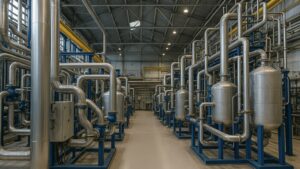Data centres currently account for a great chunk of the global electricity demand. However, based on exponential growth, they could consume over 20% by 2030 if left unchecked. This creates an urgent imperative to curb emissions. That too at scale through optimized technical design across architecture, engineering, and IT systems over lengthy, multi-decade building lifecycles. Left unabated, data centre expansion threatens to consume more total power than major countries within a decade.
We can no longer view site energy minimization as a secondary concern – it must become integral to capacity scaling. This article extensively examines location-wide best practices in data centre design for energy efficiency. This is while enabling cutting-edge computing capacity through smarter design thinking. Moreover, the strategies across sectors explored here can help anchor firm commitments. These are required to restore the sector’s growth trajectory to a sustainable path. So, let’s get started.
Best Practices in Data Centre Design: Site Selection
The site selection process fundamentally governs a data centre’s sustainable operations potential and climate risk exposure over multi-decade lifespans. So, careful location analysis should encompass future grid capacity, long-term climate impacts, and potential for complementing renewables:
Climate Impact Modeling
Conduct detailed regional climate studies through 2050 and beyond, modeling temperature, humidity, and extreme weather projections. This is to inform site selection and also minimize geographical risk exposure. Moreover, factor in impacts on cooling degree days for sustainable data centres.
Grid Capacity Evaluation
Verify locations offer robust connections to utility-scale electrical infrastructure and substations. This is with adequate capacity, redundancy, and supply infrastructure. It is to handle peak projected IT power densities for at least 30 years.
Onsite Renewables Analysis
Review the technical and financial viability. This is of integrating rooftop solar PV and battery storage, micro wind turbines, or tri-generation. Furthermore, it should be based on efficiency incentives, reliable generation capacity, and long-term policy support.
Spatial Provisions for Expansion
Design sites to accommodate possible build-out phasing. This is for increased data hall densities and redundant capacity growth. It should be across additional connected structures to house fluid future needs. This is one of the best practices in data centre design for energy efficiency.
Best Practices in Data Centre Design: Envelope Performance
The building enclosure fundamentally governs conductive, moisture, and air heat flow exchanges alongside passive thermal functionality. So, well-designed enclosures offer significant efficiency advantages for sustainable data centres:
Codes and Standards Analysis
Review insulation specifications against jurisdiction codes alongside green building standards. This is for high-performance commercial construction like LEED. Furthermore, analyze mechanical cooling system types and IT environment parameters. So, it is to appropriately elevate assembly requirements.
Cool Roofing Solutions
Specify high solar reflectance roof membranes or coatings to minimize thermal gain. Additionally, ensure that the options specified can structurally handle projected rooftop mechanical equipment loads. This is over a 30+ year weathering lifespan alongside periodic recoating.
Air and Water Control Layers Integration
Carefully integrate water-resistive barriers and vapor retarders on appropriate wall assembly layers. This is to protect the insulation and prevent interstitial condensation alongside moisture damage and also building repairs over lengthy operational lifecycles.
Thermal Mass Integration
Expose interior brick, concrete, or high-heat capacity finishes. This is to passively absorb and stabilize peak day/night temperature variations, reducing active cooling demands. Thermally massive floors also provide beneficial radiant cooling.
Best Practices in Data Centre Design: Structural Configuration
Data centre structural systems definition as one of the best practices in data centre design enables adaptable, configurable use of interior volumes for housing high-density hardware:
Interstitial Zone Dimensioning
Incorporate at minimum 24-inch structural raised floors for flexible underfloor cool air distribution. This is alongside similarly dropped modular ceilings allowing MEP accessibility without disruption.
Equipment Vibration Isolation
Mount generators, UPS units, and pumps on isolator pads or platforms. These should be tuned to dampen operational vibration frequencies. These are also harmful to sensitive computing hardware down to acceptable amplitudes per standards.
Lateral Force Resisting Systems
Design primary wind force resisting frames, shear walls, braces, and connections. This is to maintain structural integrity through location-specific peak wind speeds and also seismic events per applicable codes for multi-decade resilience.
Reconfigurable Layout
Standardize raised floor and overhead grid dimensions for scalable high-density rack bay and aisle also rearrangements as needed over decades. Moreover, coordinate modular MEP infrastructure.
Best Practices in Data Centre Design: Mechanical Systems
Engineering efficient data centre cooling, electrical, emergency, and ancillary systems offer some of the greatest combined energy savings potential long term. So, let’s take a look:
Right-sized Cooling Approach Selection
Based on climate and hardware density projections alongside heat reuse potential, perform a cost-benefit analysis on air vs liquid cooling, free cooling integration, thermal storage, and water usage when specifying mechanical systems for projected server inlet conditions over decades.
On-site Cogeneration Analysis
Review integration of electricity generation. This is from rooftop solar PV, micro wind turbines, fuel cells, or excess heat capture turbines. So, it is to cover partial facility needs where incentivized for 30+ year lifetime cost feasibility and emissions reductions.
Waste Heat Reuse Strategies
Based on proximity feasibility, design heat exchangers and pumps. This is to provide data centre waste heat to offset winter community heating loads via pipes to local buildings or districts. Alternatively, convert excess heat on-site to cooling through absorption chillers.
Water Use Reduction
Source cooling tower make-up and irrigation water from non-potable supplies. It includes harvested rainwater, stormwater, treated sewage effluent and also air handler condensate capture. This is to minimize potable water demands following shortage risk assessments for the region.
Best Practices for Energy Efficiency: Ongoing Operations
To enable sustained efficiency across lengthy lifespans, comprehensively approach data centre operations:
Sensor-based Monitoring
Continuously track granular facility and component energy use aligned with weather and IT capacity metrics. So, this is through historically searchable data lakes, analyzing deviations to catch developing efficiency limit breaches.
Automated Control Sequence Optimization
Using expanding operational runtime datasets, periodically re-tune automated lighting, cooling, and other HVAC control software routines. This is for alignment with actual occupancy patterns. It is also for demand schedules rather than theoretical models.
Predictive Maintenance Rigor
Apply machine learning algorithms to temperature, vibration, voltage, and other time-series infrastructure sensor data. It is to predict component failure likelihood and also optimize repair labor allocation.
Sustainable Technology Refresh Cycles
To sustain compute output gains per energy unit, plan regular IT equipment replacement every 3-5 years. It should also be in line with advancing rack power density improvement rates.
To Sum Up
Best practices in data centre design for net zero carbon involves scrutinizing everything. This is from location climate impacts down to server configuration specifics in an integrated fashion. So, careful consideration at every level collectively compounds operational efficiency savings and emissions reductions. This is for the climate at scale over lengthy usable building lifecycles.
Industry forums like the Net Zero Data Centre Summit in Berlin, Germany on 1-2 February 2024 convene experts. This is to transfer best practices in data centre design to maximize energy productivity. So, make sure you check about the summit and take advantage of the opportunity as experts!





